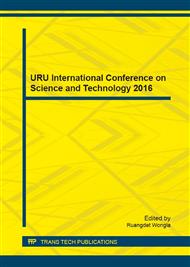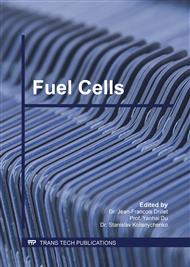p.65
p.70
p.75
p.82
p.91
p.98
p.103
p.108
p.114
Electricity Production from Organic Wastes Fermentation by Microbial Fuel Cell Process
Abstract:
This research studied the electricity production from organic wastes fermentation by microbial fuel cell by using a single chamber microbial fuel cell (SCMFC). Two sizes (1 L and 10 L) of simple SCMFC were fabricated by using a cylindrical plastic tank which anode compartment and cathode compartment separated by plastic plate with hole and covered with cotton fabric. The anode electrode contacted with organic matter and microorganisms where anaerobic reaction occurred to generate electron and proton. The electrons transferred through an external circuit while the protons diffused through the solution to the cathode electrode for reducing oxygen to water. From the study of the effect of different electrode types (carbon graphite rod, zinc metal, and copper metal) to the electricity generation using the SCMFC size 1 L in fermentation with synthetic sweetness solution (22%Brix) and the effective microorganism (EM) for 36 hrs, it found that the fuel cell which used copper metal as electrode produced electricity increasing over the times and has more efficient than the other electrode types. The study of electricity generation from organic waste fermentation by using the SCMFC size 10 L and using copper metal as electrode, the results showed that the fermentation of pineapple waste produced the current density, potential density, and power density higher than the fermentation of bananas and the fermentation of food garbage with EM. An optimal period of time for the production of electricity from this microbial fuel cell is the first five days of fermentation that the cells has voltage »500 mV, the current density 25.52 mA m-2, potential density 104.69 V m-2 and power density 12.59 mW m-2, and then decline over time five days (120 hrs). Moreover the bio-liquid fertilizer and the residues from the fermentation can be further used in agricultural because of the nutrient content (N, P, K), organic carbon and organic material contents available.
Info:
Periodical:
Pages:
91-97
Citation:
Online since:
October 2016
Authors:
Keywords:
Permissions:
Share:
Citation:



